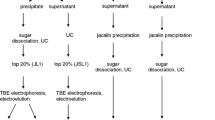Abstract
The resistance to association of circulating multiply-modified low-density lipoproteins (LDL) isolated from human blood and characterized by a decreased content of sialic acids in comparison with native LDL was studied by analysing light transmission fluctuations. LDL association was stimulated by decreasing environmental ionic strength. It is established that circulating modified LDL are less resistant to association than native LDL. Association of LDL in a medium with low ionic strength was irreversible. Probably, increased capacity to irreversible association determines the atherogenic properties of circulating modified LDL subfraction.
Similar content being viewed by others
REFERENCES
H. Sontag and K. Strenge, Coagulation and Stability of Disperse Systems [in Russian], Leningrad (1973).
A. N. Klimov and N. G. Nikul’cheva, Lipids, Lipoproteins, and Atherosclerosis [in Russian], St. Petersburg (1995).
V. V. Tertov (1999) Angiol. Sosud. Khir. 5 IssueIDSuppl. 218–240
M. A. Austin J. L. Breslow C. H. Hennekens et al. (1988) JAMA 260 IssueID13 1917–1921
P. Avogaro G. B. Bon G. Cazzolato (1988) Arteriosclerosis 8 IssueID1 79–87
J. L. Goldstein M. S. Brown (1977) Annu. Rev. Biochem. 46 897–930
L. J. Hazell J. J. M. Berg Particlevan den R. Stocker (1994) Biochem. J. 302 IssueID1 297–304
H. F. Hoff T. E. Whitaker J. O’Neil (1992) J. Biol. Chem. 267 IssueID1 602–609
A. A. Orekhov V. V. Tertov D. N. Mukhin (1991) Atherosclerosis 86 IssueID2–3 153–161
V. V. Tertov V. V. Kaplun A. A. Orekhov et al. (1998) Atherosclerosis 138 IssueID1 183–195
V. V. Tertov A. A. Orekhov (1997) Exp. Mol. Pathol. 64 IssueID3 127–145
V. V. Tertov A. A. Orekhov I. A. Sobenin et al. (1992) Circ. Res. 71 IssueID1 218–228
V. V. Tertov I. A. Sobenin Z. A. Gabbasov et al. (1992) Lab. Invest. 67 IssueID5 665–675
V. V. Tertov I. A. Sobenin Z. A. Gabbasov et al. (1989) Biochem. Biophys. Res. Commun. 163 IssueID1 489–494
V. V. Tertov I. A. Sobenin A. G. Tonevitsky et al. (1990) Biochem. Biophys. Res. Commun. 167 IssueID3 1122–1127
Author information
Authors and Affiliations
Corresponding author
Additional information
Translated from Byulleten’ Eksperimental’noi Biologii i Meditsiny, Vol. 138, No. 9, pp. 280–283, September, 2004
Rights and permissions
About this article
Cite this article
Panasenko, O.M., Suprun, I.V., Mel’nichenko, A.A. et al. Low ionic strength promotes association of circulating modified LDL human blood. Bull Exp Biol Med 138, 248–250 (2004). https://doi.org/10.1007/s10517-005-0012-0
Received:
Issue Date:
DOI: https://doi.org/10.1007/s10517-005-0012-0




